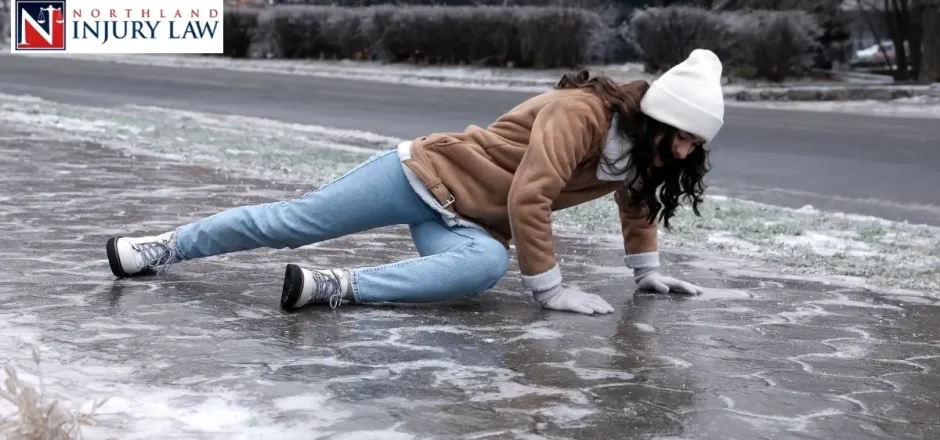|
|
Last
Modified on
Apr 09, 2025
As people go about their lives, most probably assume all sidewalks are safe. Unfortunately, a crack in the pavement, chipped piece of concrete, or sudden change in elevation can shatter that assumption in a split second. Slips, trips, and falls can result in serious, sometimes life-threatening injuries. More than 80,000 people end up in the hospital every year from serious fall injuries, most often suffering from head trauma or a broken hip. After suffering such an injury, many wonder, “Who is liable for a sidewalk slip and fall?”
When damaged or slippery sidewalks cause severe injuries, it’s understandable to want compensation. Here’s what you need to know about determining who is responsible, and how to build a strong claim.
Requirements for Residential and Business Sidewalks in Missouri
While the municipality or city may be responsible for some sidewalks throughout an area, homeowners and business owners are responsible for the ones on their private properties. It’s the property owner’s responsibility to keep the sidewalks around their property safe for pedestrians. In general, home and business owners must repair cracks, uneven pavement, and buckling in the sidewalk adjoining their property.
Their responsibility includes timely removal or treatment of snow and ice, depending on city ordinances. The same sidewalk safety requirements apply to condominium and apartment complex owners.
Private property owners can sometimes receive notices from the city based on the city’s sidewalk regulations. The notice is an order to repair what the municipality determines is a defect or dangerous condition. The property owner’s failure to repair the problem can result in a ticket. In some cases, the city repairs the damage and charges the property owner for the cost of repairs.
If you fell over a bicycle your neighbor’s child left on the sidewalk in front of his parent’s home, the parents may be responsible. A store owner may be responsible if you suffer a sidewalk injury by slipping and falling on accumulated ice or snow in front of the store.
You could also file a claim against the city if you sustained an injury on a sidewalk owned by a government entity.
Proving Liability for a Sidewalk Accident in Missouri
When a property owner responsible for a public sidewalk knows or should know about a problem and fails to fix it, they’re negligent. If their negligence results in injuries, then the property owner is liable for the injured person’s damages.
Damages for personal injuries can include the cost of:
- Medical and dental treatment
- Out of pocket expenses
- Lost wages
- Pain and suffering
A property owner isn’t liable every time a pedestrian gets hurt on their sidewalk. Owners are legally entitled to a reasonable amount of time to discover a dangerous sidewalk condition and do something about it.
For example, let’s say a heavy snowstorm came in overnight. A pedestrian walking down Main Street at midnight, while it was still snowing, slipped and fell in front of a closed candy store.
In this case, the candy store owner probably would not be liable. There just wasn’t a reasonable amount of time for the store owner to remove the snow.
Most cities allow businesses and homeowners from four to 24 hours to clear public walks. Many lawmakers only require snow removal during daylight hours.
To prove liability for sidewalk injuries, you must show:
- The property owner was aware or should have been aware of the dangerous condition.
- A reasonable person would know the dangerous sidewalk could result in injuries.
- The property owner did not take reasonable steps to correct the dangerous condition.
- The property owner’s negligence was the direct cause of your injuries.
- Your injuries are real and verifiable.
- You didn’t contribute to the circumstances that caused your injuries.
Understanding Contributory Negligence vs. Comparative Negligence in Missouri
Contributory Negligence rules affect personal injury claims in Alabama, Maryland, North Carolina, Virginia, and the District of Columbia. If the insurance company blames you as little as one percent for your injuries, they can use pure contributory negligence rules to deny your claim.
Comparative Negligence or modified comparative negligence rules are used in most states. Under comparative fault rules, you have the right to pursue an injury claim even if you’re partially to blame for your injuries. Your compensation is reduced in proportion to your share of the blame.
Common Causes of Sidewalk Accidents in Missouri
Whether you’re out for a scenic stroll or briskly walking to an appointment, the last thing you expect is a painful trip and fall injury. Some of the most common causes of sidewalk injuries are:
- Cracks: Large cracks are quite common in sidewalks. Cracks can develop over time from age, soil conditions, tree roots, weather changes, and seasonal temperature changes. Sometimes cracks result from inferior materials used to build or repair the sidewalk.
- Buckling: Large, uneven slabs of broken concrete are often caused by tree roots pushing up from underneath the sidewalk.
- Uneven pavement: Uneven sidewalks develop when concrete or asphalt separate. Pooling water can freeze and heave up sections of pavement, as can tree roots, or heavy traffic, like where sidewalks cross driveways. Kansas City Public Works started a concrete shaving project to fix sidewalk tripping hazards, removing up to 1.5 inches to minimize trip and fall injuries in their city.
- Grates and manholes: City sidewalks often have embedded metal grates, manhole covers, or cellar doors. Deterioration of the metal object or the concrete edging can cause dangerous holes and uneven walking surfaces.
- Gas caps: Gas and utility pipes with caps that stick up from sidewalks are trip hazards for pedestrians.
- Loose bricks: Cobblestone walkways are quaint and picturesque but can be dangerous when bricks or stones are crumbling, broken, or missing.
- Snow and ice: Failure to remove snow and ice from walkways can lead to severe slip and fall injuries. Missouri’s fairly flat topography and general location in the United States make it prone to dry-cold air masses, snowfall, and rainfall. Snow can fall in the state as early as October and as late as May. On average, areas north of the Missouri River average 18 to 24 inches of snow, while southern counties see about eight to 12 inches.
- Construction flaws: Dangerous sidewalks can result from using the wrong materials for the location and weather, not considering drainage for the area, and improper installation or repairs.
- Debris: Trashcans, overflowing trash, fallen leaves and tree limbs, and children’s toys are just some of the material that can cause a pedestrian to trip and fall.
Why Work With a Missouri Sidewalk Injury Lawyer?
Falls are the leading cause of both nonfatal and fatal injuries in people aged 65 and older in Missouri. In 2020, approximately 316,215 elderly Missourians reported falling. Moreover, 740 people in Missouri aged 65 and older died due to falls the following year.
While falls are more prevalent in older adults, no one is safe from sustaining an injury from unsafe sidewalk conditions. A Missouri sidewalk injury attorney can seek legal recourse on your behalf after an injury. They can recover the full scope of compensation you deserve.
FAQs
What Is the Statute of Limitations for Sidewalk Injury Cases in Missouri?
If you’re filing a sidewalk injury claim against a home or business owner in Missouri, you typically must do so within five years of the incident. In some cases, you may not develop symptoms or discover an injury until some time after the fact. Missouri follows the discovery rule, so you could file within five years of noticing an injury caused by the incident in this case.
How Much Can I Win From a Sidewalk Injury Case in Missouri?
The total settlement amount you can win from a personal injury case depends on the specifics of your case and the severity of your injuries. Moreover, Missouri is a comparative fault state, which means you can receive a smaller settlement if you’re found partially at fault for your injury. Fortunately, Missouri does not have a cap on damages, so there is no limit to how much you can win.
How Do I Determine Liability in a Sidewalk Injury Case in Missouri?
Typically, homeowners and business owners are responsible for taking care of the sidewalks on their property, which means you might file against them for an injury sustained on their sidewalks. Any sidewalks not on private property typically fall under the control of the city or municipality. A skilled attorney can study your case to determine who is at fault for your injury.
Are Sidewalk Injury Cases Difficult to Win in Missouri?
Winning a sidewalk injury case can be challenging, but it’s not impossible, especially if you choose to work with a Missouri personal injury lawyer. To win your case, it’s crucial to gather strong evidence that establishes the other party’s fault and demonstrates how the incident caused you injury or harm.
Get in Touch With a Missouri Sidewalk Injury Lawyer to Discuss Your Case in Detail
If you’ve been injured and aren’t sure where to turn, let our team at Northland Injury Law help. We represent individuals in many areas of personal injury, including property liability cases, like sidewalk trips and falls. Contact us to set up an appointment with a Missouri sidewalk injury attorney today.









